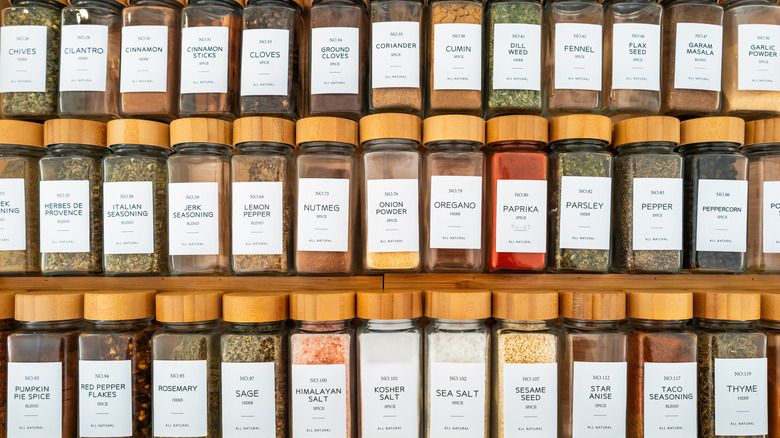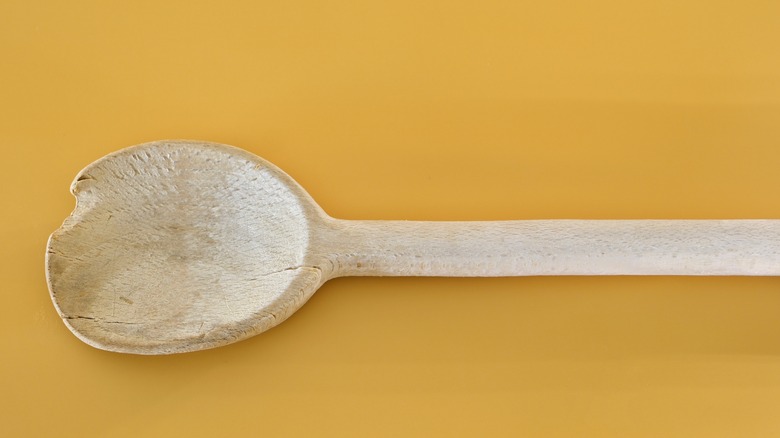7 Items In The Kitchen That You Should Get Rid Of ASAP
The kitchen seems to be one of the most cumbersome places to clean. Not only do surfaces like countertops and sinks need a good weekly scrubbing to keep harmful bacteria and unruly pests at bay, but you're also advised to constantly declutter your cabinets and shelves to keep up with disorder. However, some things need to be kicked to the curb faster than others. For example, while your disorganized traveling mug collection might give you anxiety every time you open the drawer (why do we always have at least 10 different options?), it doesn't need to be organized right then and there. However, those chipped mugs that might end up cutting your lip or harboring bacteria? That needs to go ASAP.
Decluttering the kitchen can feel like a huge project, so it's much easier to break it up into manageable chunks. That way, you don't have to spend a full day tidying your cupboards and cabinets. The best way to start the monumental task is to remove the things that need to go ASAP. These are items that can either create a hazard, serve no real useful purpose, or that create unnecessary clutter. Get those out of the way today, and then move on to the more granular stuff later. Here is what to toss or donate first — take a look below!
Chipped dishware
While it may feel difficult to toss out chipped dishware — especially if it's part of a set — it's something you should strongly consider. The cracks and crazing aren't just about aesthetics — they can also help spread pathogens and breed bacteria. That's because bacteria can settle into those porous chips, and hairline cracks are difficult to properly clean and get all the food out. This opens the door to dangerous germs like Pseudomonas to settle in, which can cause pneumonia or blood infections. Even if you try to fix the dish, if there is a seam left behind, you're opening yourself up to risk. "Seams, where the pieces were mended, will absorb moisture more readily and could develop bacterial growth that can weaken joints and be hard to clean," Forrest Lesch-Middelton of FLM Ceramics told Marth Stewart.
There are other dangers involved as well. Some dishes have lead in them to make them more durable, and the ceramic glaze acts as a protective barrier that keeps it inside. If the dishware cracks or chips, you are now exposed to that risk. According to the FDA, handmade, antique, and brightly colored ceramic dishware may contain lead, so be extra careful about getting rid of those pieces as they chip. They are not worth keeping.
Expired spices
Whether you're a master chef in the kitchen or only dabble with Pinterest recipes now and then, having a stockpile of half-empty and expired spice bottles is only creating clutter in your kitchen. While there may not be a best-before date on all your bottles, there are general timelines you can follow in order to ensure you're not holding onto an expired collection. Extracts will start to fade after two years; whole spices are best to be used in the first three years of purchase, while ground ones should be tossed after two years, and leafy herbs have a shelf life of around one year. The exceptions to these rules are vanilla extract and salt, which will last forever.
Spices aren't just used for cooking but also for cleaning and even pest control. Cayenne pepper can keep mice away, cinnamon can freshen your home, and bundling spices can even keep moths out of your closet. However, if you attempt these hacks with expired materials, you may not get the desired results, so take the afternoon to go through your spice drawer and clean up some space to restock.
Plethora of mugs
We all know how easy it is to get into the habit of collecting mugs. Whether you source them during your travels, accidentally bring them home from the office, or get carried away by new designs at Target, it happens to the best of us. But when it becomes clear that your mug cabinet is no longer functional because it's overflowing with pieces you barely use, it's time to declutter. Ideally, your number of mugs reflects the number of people in your household and how many cups they use in a day. If there are two people in your home and you use three mugs a day, your cupboard should have between six to 10 mugs. If you have nearly 20, you know it's time to thin out the collection.
But deciding what to keep and what to get rid of can be tricky. Luckily, there are a couple of questions you can ask yourself to decide what to part with and what to keep. First, ask yourself if it's damaged or chipped. If it is, toss it. Then, be honest if you have used it in the past year. If not, consider donating it. Next, does it have sentimental value? If it does, consider displaying it somewhere else or creating a separate memory box you can pack it in. And lastly, does drinking out of it make you happy? If it doesn't, consider putting it in the donation box.
Lidless plastic containers
We all have plastic food containers that have somehow lost their lids and no longer serve a purpose. Yet they still take up large chunks of our kitchen cabinets even though we will never use them. Rather than holding onto them, take the afternoon to either toss or repurpose them. You will likely be amazed at how much extra storage you have once you clear them. To avoid this issue in the future, organize your storage container drawer so the containers and lids are always together. This will help you avoid mismatched pieces and will help keep your lids from somehow disappearing into the ether. Simply snap the lids onto the containers and stack them on top of each other according to size and style.
If your cabinet doesn't have enough room to do that and you need to nestle the containers into one another, then take a different approach. For example, you can use a Dollar Tree storage hack that keeps your container lids organized. Grab a wire cabinet riser from the dollar store, and nestle each lid in between a wire slot. This will help keep them upright and easy to spot. Pop it into your cabinet and put your containers next to it. Every time you need a plastic food container, you can match up the two pieces and pull them out.
Peeling non-stick pans
Peeling nonstick pans aren't only creating clutter, but they might also be dangerous. Because of this, they should be disposed of ASAP. Nonstick pans are coated with polytetrafluoroethylene, also known as teflon, which is made up of a mix of fluorine and carbon atoms. If used in no higher than 500-degree heat, these pans are perfectly fine. However, if you really crank up your stove and overheat these pans, they not only can release toxic chemicals into the air, but bits of the teflon can flake away into your food. While the science community is divided over how dangerous that could be, you might want to err on the side of caution.
While more studies are needed, as of right now, it's believed that getting small amounts of Teflon into your body isn't overly dangerous. However, there have been rare cases of polymer fume fever, which can cause lung damage after inhaling degrading teflon heated to high temperatures, as per BMJ Case Reports. Research has also linked it to reproductive issues and cancer risks, so it doesn't come without its dangers. Because of that, remove any scratched, flaking, or peeling nonstick pans and replace them with new ones.
Cracked wooden spoons
While it's easy to keep using the same spoon you've had since your first apartment post-grad, using cracked, wooden cooking utensils is the next item in your kitchen you should declutter as soon as possible. Much like chipped dishware, moisture can get trapped in the cracks and allow harmful bacteria to grow. Wood is also very porous, which means that the bacteria doesn't just sit on the surface but also makes its way inside. However, this isn't usually something to worry about since that bacteria doesn't transfer. The only time it does is when the items chip or splinter, exposing the pathogens stored up inside and allowing it to transfer to your food.
To avoid this in the future, practice proper cleaning practices with your wooden utensils. Instead of using the dishwasher, try hand washing with a mild dish soap. The dishwasher will add too much water and heat, which will splinter and crack the utensils. Allow the items to thoroughly air dry before storing them back into their drawers, which will help keep bacteria and mold risks at a minimum. And if your items are looking a little dry, consider conditioning them with food-grade mineral oil or beeswax every few months to extend their shelf life and keep them from cracking.
Scratched cutting boards
The last item in your kitchen that should be removed is any and all cutting boards that have deep knife grooves in them. Going along with the common theme, the grooves in your old board have the possibility of trapping moisture, which can cause dangerous bacteria to grow that can't be washed out. "The more grooves it has, and the bigger they are, the more area is available for trapping moisture and giving bacteria a place to proliferate," Ben Chapman, a food safety researcher, told North Carolina State University. According to the USDA, once these thick grooves develop, it's time to toss them.
While you can't really stop knife marks from forming, you can choose your next cutting board more carefully so it doesn't happen as often. Plastic cutting boards are more susceptible to cuts, as are softwood cutting boards. "That's because they have larger grains, which allows the wood to split apart more easily, forming grooves where bacteria can thrive," Chapman explained. Instead, try a hardwood board, such as maple.







